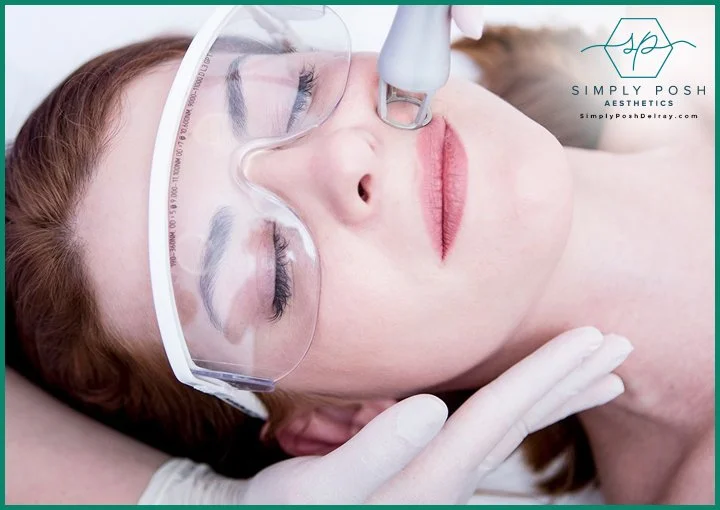How does laser skin resurfacing work?
People have heard of laser skin resurfacing, but few know the scope of this procedure -- and how it helps correct or improve several skin conditions and issues with minimal downtime, few side effects, and lasting results. If you are wondering whether laser resurfacing may be right for you, this article offers a comprehensive overview of what you need to know!
Laser skin resurfacing works by removing the top layers of the skin to stimulate the growth of new skin cells and the production of collagen. This can decrease the appearance of fine lines, sun damage, and other signs of aging.
Also, laser skin resurfacing can help reduceTrusted Source visible scarring and some other skin conditions.
Doctors call laser skin resurfacing an ablative therapy, which refers to the fact that it actively removes layers of the skin.
A less invasive type of laser treatment, known as laser skin rejuvenation, is non-ablative, as it does not injure the skin’s surface. Although this can shorten the recovery time, the results may be less pronounced.
In this article, we will look more closely at what laser skin resurfacing is, for whom it is safe, what results it can produce, and what happens during a session. We will also look at the recovery process and potential risks.
What is laser skin resurfacing?
Laser skin resurfacing is a cosmetic procedure that involves a dermatologist directing a laser onto the skin. The laser removesTrusted Source the top layer of skin cells, known as the epidermis, and the outer cells of the dermis, which is the second layer of the skin.
The procedure works by stimulating the growth of new skin cells and the production of collagen, a protein that gives skin its structure. Age decreases the body’s ability to build new collagen, so by stimulating its production, laser skin resurfacing can help the skin appear plumper.
Laser skin resurfacing may reduce the appearance of:
age spots
scars, including from acne
fine lines and wrinkles
warts
some types of birthmark
large pores
sun damage
There are many different types of lasers dermatologists can use on the skin. The two most common types are carbon dioxide lasers, which remove scars, wrinkles, and warts, and erbium lasers, which remove lines and wrinkles. Erbium lasers typically cause fewer side effects.
Laser skin resurfacing is ablative, which means it involves injuring the skin. A related procedure — laser skin rejuvenation — is non-ablative, meaning it does not remove any skin.
Ablative laser resurfacing offers more dramatic results, but it can cause more side effects, including pain and skin damage.
Non-ablative laser treatment has a lower risk of side effects, but the results are typically less pronounced.
What results to expect from laser skin resurfacing?
Immediately after laser skin resurfacing, the skin may be sore and irritated. This can last several days. A person will also have increased sensitivity to UV light, which can last up to 1 year.
However, as the skin regrows, people typically notice that the skin looks plumper. Age spots, wrinkles, and dull skin are less noticeable. The skin may look softer, smoother, or more moisturized.
Laser skin resurfacing cannot mimic the results of a face lift, but it will improve the skin’s surface by reducing the appearance of:
lines
age spots
discoloration
scarring
The skin can continue to improve in appearance for up to 1 year following treatment.
The effects of laser skin resurfacing are permanent when it comes to issues such as scarring. Once a specific scar is gone, it will not come back.
However, with regard to the visible signs of aging, the results are not permanent. Most people notice that their skin looks younger for several years following treatment, but as aging continues, signs of aging will begin to show again.
A person can repeat laser skin resurfacing to try to maintain the results.
Who can have laser skin resurfacing?
Laser skin resurfacing is effective for many people who want to see dramatic improvements in the surface of their skin.
However, it is not a good option for everyone. This includes people who:
have a history of keloid scars, as they may develop scars in response to the procedure
have very dark skin — Fitzpatrick types 4 through 6Trusted Source — as they may develop skin discoloration
have excess skin or deep wrinkles
are taking oral isotretinoin
have active herpes
have skin conditions, such as scleroderma or psoriasis
have recently had a chemical peel
The procedure
Before the first laser skin resurfacing session, a healthcare professional will take a person’s medical history to make sure the procedure is safe for them. They will then explain the potential benefits and risks and what the recovery and aftercare entail.
Next, they may recommend a series of skin treatments prior to laser resurfacing. These usually begin at least 6 weeks in advance and can help minimize the risk of complications.
Laser resurfacing sessions typically take 30–120 minutes, depending on the size of the treated area. It is a painful procedure, so a doctor will administer an anesthetic.
If the area is relatively small, this will be a local anesthetic. Some individuals may also take a sedative to help them relax.
For larger treatment areas or for when a person is undergoing several procedures at once, a doctor may suggest general anesthesia. This causes unconsciousness.
During treatment, the doctor applies a laser to remove targeted skin cells. After the procedure is over, they will dress the skin in a protective bandage.
A person will need observation until anesthesia wears off, but they can usually go home the same day. In most cases, someone else will have to take the patient home.
Aftercare
Aftercare is important following laser skin resurfacing. The skin may be swollen and sensitive after a session. It will also remain vulnerable to sun damage for some time afterward.
A dermatologist can provide detailed instructions on how to care for the skin as it heals. Immediately after a session, they may recommend:
applying ice packs or cool compresses for swelling
keeping the head elevated
using petroleum jelly to protect the skin and reduce irritation
bathing in salt water to aid healing
using dressings to cover the skin
avoiding smoking, as it slows healing
For persistent inflammation, swelling, or irritation, they may prescribe a mild steroid cream. If an individual develops an infection, they may need antibiotics. It is advisable to ask a dermatologist before applying anything else to the skin while it heals.
It is essential to avoid exposing the treated skin to the sun. A person should avoid being outside in sunny weather, wear wide-brimmed hats or other clothing to shield the skin, and wear SPF of 30Trusted Source or higher.
It is also important to monitor for signs of infection, such as:
fever
intense pain
pus
rash
Call a doctor immediately if these signs appear.
Risks and side effects
Most side effects of laser skin resurfacing are temporary. After a session, the skin may feel:
inflamed
swollen
itchy
sore or painful
These symptoms tend to last several days. It is normal for the skin to become dry and start peeling after 5–7 days.
Some individuals develop skin that looks severely sunburned, with oozing, crusting, or blistering. They should not scratch this off, as it can lead to scarring.
Another side effect for all people undergoing this procedure is increased sensitivity to the sun. It will be easier to get sunburn, and exposure to the sun may cause hyperpigmentation. This is when patches of skin become darker than the surrounding area. It can take up to 1 year for this effect to wear off.
Some other risks include:
milia
acne
reactivation of cold sores
uneven skin tone, especially in dark complexions
bacterial infection
severe sun damage if a person does not wear sunscreen
Rarely, laser resurfacing causes scarring.
How much does laser skin resurfacing cost?
The cost of laser skin resurfacing will depend on the location and the experience of the doctor performing the procedure.
The American Society of Plastic Surgeons estimates that the average cost of ablative laser resurfacing is $2,509, and of non-ablative laser resurfacing — $1,445.
Summary
Laser skin resurfacing works by removing the outer layers of the skin to encourage new collagen and skin cell production. It can reduce the appearance of scars, wrinkles, age spots, and sun damage, among other things.
As with any cosmetic procedure, it is important to choose a skilled, experienced healthcare professional, ask for photos of results, and inquire about risks and benefits of treatment.
For most people, the results will last several years and can be permanent if a person is using laser resurfacing for scar treatment.
Questions? Simply Posh is here to answer any questions you may have -- we also offer unparalleled professional dermatological and cosmetic services to help you look and feel your best! Our patients enjoy the latest technology — with a team that genuinely cares about your confidence, self-esteem, and maintaining your natural beauty. Book a complimentary consultation with us here or find us on Facebook.
Reference: [https://www.medicalnewstoday.com/articles/laser-skin-resurfacing#summary]



